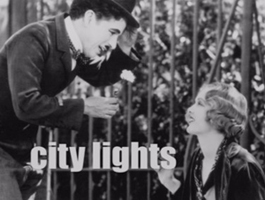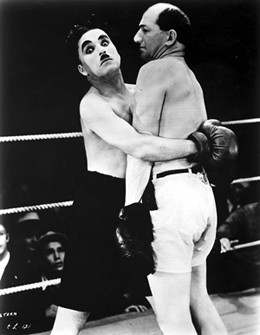Director, writer, actor, producer, editor… the list goes on. Charlie Chaplin lit up the screen with his brilliance in all areas of film. This multifaceted film maker was at the top of his career when he made one of his most famous films City Lights, which brought forward a whole new degree to film with his genius techniques and extravagant style. Chaplin knew how to make an audience laugh and cry within minutes of a scene. Chaplin, one of the most talented actors, could do all this without dialogue and speech. All of these examples of his work could simply be shown in one movie and City Lights was it.

City Lights is the story of a young Tramp (played by Charlie Chaplin) that falls in love with a beautiful Blind Flower Girl (Virginia Cherrill) that is financially troubled and is helped also by a struggling Tramp to try and cure her blindness. Along the way the Tramp experiences many misadventures and meets new people along the way in this 1931 classic.
From the opening scene, with the fantastic music Chaplin created, finding The Tramp asleep on the newly unveiled statue with the “Star Spangled Banner” playing, with Chaplin’s humorous gestures and his ignorance of the circumstance is just sheer hilarity with the officers trying to handle the situation. Moving on to the sappy first appearance of the Blind Flower Girl and the Tramp as he purchases a flower and quietly observes the girl sitting on the ledge just brings a smile. Notably one of the most famous scenes in the entire film would have to be the boxing match. From the build up in the locker room and how Chaplin’s opponent had to “split” so their plan of dividing the prize money fifty-fifty is out the window and a new tougher opponent flies right in at the grasp of the Tramp. To the actual fight where the Tramp uses his quick feet to ensure that the referee is between him and his opponent at all times. Witnessing this simple yet hilarious humor brings nothing but an outburst of laughter. Although this film had so many incredible scenes none of them are as perfect as the ending sequence where we see the Blind Girl, now cured, and the Tramp being pestered by young delinquents as both of them see each other for the first time. As the girl grabs the Tramp’s hand while being completely oblivious to the fact that it’s her lover, now realizing it is as the Tramp says, “You Can See Now?” and she simply replies, “Yes, I Can See Now.” Implying that her eyes are open to the world and she’ll accept him for who he is even though he’s a Tramp.

The score is just spectacular, it all fits together so well, and to think that Charlie Chaplin was not only the man behind the movie, but also wrote the music as well. The music adds so much character to Chaplin’s already amazing performance in the film and it really adds texture and illuminates his performance, and to do it all without the benefit of dialogue.
In the silent era of film, it was basic technology and the footsteps that paved the way for modern movies. They didn’t use high-tech cameras yet they still got their point across with the way they utilized their original techniques and spellbinding storytelling. Some of my favorite shots in City Lights are when we see the Millionaire for the first time attempting to commit suicide and the Tramp spots him and tries to save him as the noose gets tangled up between the two and they both end up falling in the water. A simple shot like the shot Chaplin used in the film was good enough, he conveyed his point to the audience and how we should feel at that point in the film. Another great scene was the overhead shot in the film where the Tramp and the Millionaire are driving through the city drunk ramming into fire hydrants and getting into other mishaps.

City Lights is such a great film overall and expresses itself in so many different ways. There are many themes that give out a broadening view of how life was like and how certain people got treated in different ways. One of these themes is how the Tramp got tormented even by children just because he was a poor individual. It’s really a social commentary like in most of Charlie Chaplin’s films on how civilization and society treats poor people badly. Another poignant theme in the end scene where, even though Chaplin’s character is poor, the girl is still able to accept him for who he is and not treat him any differently than if he were rich. In the grand scheme of things, it doesn’t really matter whether you’re rich or poor, in a perfect society you should be able to look beneath all the stereotypical undertones and appreciate who someone really is and I think that this film portrayed that perfectly.
Charlie Chaplin’s films have made their place in history and are still some of the greatest films ever made. I would highly recommend Chaplin’s City Lights to any person of any age because I think anyone would enjoy this film. I agree with what Roger Ebert said, “Chaplin’s films will live forever, but only for those who seek them out.” Let’s hope we continue to seek out his films, especially the brilliance of City Lights.

